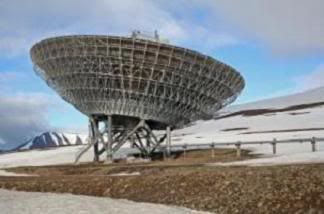Post by glactus on Mar 11, 2008 16:59:49 GMT

One of the EISCAT radars in Svalbard.
The campaign to broadcast the first ever advertisement into space was on launched March 7 with University of Leicester space scientists playing a key part in the process.
The British public is being asked to shoot a 30-second ad about what they perceive life on earth to be as part of Doritos 'You Make It, We Play It' user-generated-content campaign. The winning advert in the competition will be beamed past the earth's atmosphere, beyond our solar system and into the Universe, to anyone 'out there' that may be watching. The winning ad will also be broadcast on terrestrial TV.
On 12th June, the space-bound ad will be broadcast from a 500MHz Ultra High Frequency Radar from the EISCAT Space Centre in Svalbard, which lies in the Arctic Ocean about midway between northern Norway and the North Pole.
The transmission is being directed at a solar system just 42 light years away from Earth with planets that orbit its star '47 Ursae Majoris' (UMa). 47 UMa is located in the Great Bear Constellation (also known as "The Plough") - easily identifiable to even the most amateur stargazer. It is very similar to our Sun and is believed to host a habitable zone that could potentially harbour small terrestrial planets and support life as we know it.
Dr Darren Wright, Lecturer in the Radio and Space Plasma Physics Group, Department of Physics & Astronomy at the University of Leicester has played a pivotal role in realising this project. "There could also be potential commercial interest in enterprises like this. Imagine one day that companies on Earth might wish to advertise to other planetary colonies within our solar system --for example if man ever moves to colonise Mars!

Is anyone there
credits:
This article has been adapted from materials provided by the University of Leicester, via EurekAlert!, a service of AAAS.
This is part text only. See image, full text and all scientists involved at sciencedaily.com
www.sciencedaily.com/releases/2008/03/080307095219.htm
image credit: University of Leicester




